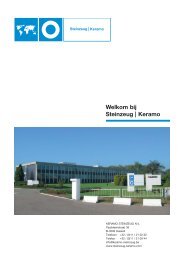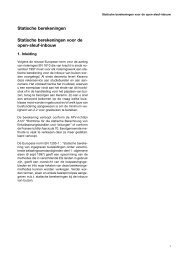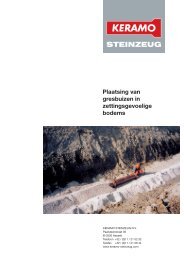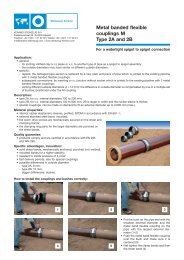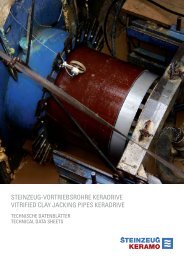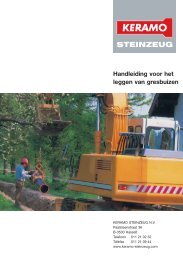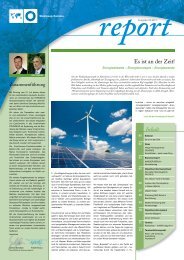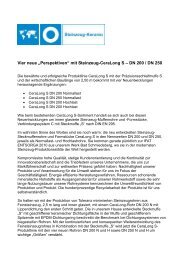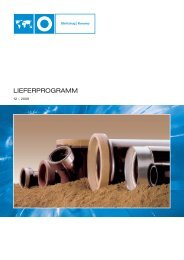mohring engels.indd - Keramo Steinzeug
mohring engels.indd - Keramo Steinzeug
mohring engels.indd - Keramo Steinzeug
You also want an ePaper? Increase the reach of your titles
YUMPU automatically turns print PDFs into web optimized ePapers that Google loves.
ately, and the depreciation figures are lowered. This in<br />
turn means lower sewerage charges. Further information<br />
on this, with examples, may be found in the article<br />
by Thymian, Möhring and Friede ”The economic significance<br />
of quality assurance in sewer construction”<br />
(STEINZEUG Information 1996).<br />
Micro-tunnelling Page 31<br />
9. Recommendations for carrying out<br />
micro-tunnelling<br />
In the public mind micro-tunnelling does not enjoy anything<br />
like the importance due to it by virtue of its technical<br />
and economic scope. Why is this? The main causes<br />
are<br />
– deficient awareness of the stage reached by developments.<br />
For operators there is in many cases still<br />
something exotic about enclosed sewer-construction<br />
methods, which are decided on only when conventional<br />
solutions appear inadvisable;<br />
– uncertainties in planning, tender-specification and<br />
preparatory matters;<br />
– distrust, especially re: success in difficult subsoil conditions;<br />
– hesitation by companies because the frequency of<br />
use once capital has been invested cannot be<br />
gauged.<br />
In a modern technical development such as micro-tunnelling<br />
there will be constantly new challenges for all<br />
concerned. Any client and any planning consultant engineer<br />
can however trigger impulses in order to increase<br />
the cost-effectiveness of micro-tunnelling in his sphere<br />
and have a hand in determining success in the market.<br />
For this the following suggestions may be helpful:<br />
1. In each sewer-construction project cost-effectiveness<br />
comparisons should be drawn up for the open<br />
and enclosed methods. In these, all factors affecting<br />
the open methods in particular should be taken objectively<br />
into account such as previous re-routing of<br />
pipes, traffic lights and necessary digging up and<br />
restoring of the road, soil replacement, dewatering<br />
and the duration of construction work.<br />
2. Where a cost-effectiveness comparison shows<br />
approximate equality, the market should be challenged<br />
with alternative specifications.<br />
3. Micro-tunnelling is unsuitable for short underground<br />
crossings of embankments, railtrack, waterways or<br />
road intersections. The longer a construction site,<br />
the more favourably do the relatively high cost<br />
shares for investment in this technology pan out.<br />
4. Frequent invitations to tender for micro-tunnelling<br />
work are signals to contractors that investing in<br />
modern technology might be worthwhile.<br />
5. Standardisation of the major elements in pipe<br />
jacking, starting, target, by-shafts and intermediate<br />
shafts and – where necessary and feasible – their<br />
subsequent incorporation in the sewage system as<br />
inspection shafts are a contribution to rationalisation.




